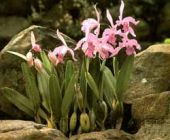

| Orchid Care for Beginners | ||||
Successfully growing orchids is no harder than growing houseplants - it's just different. Don't be embarrassed for a minute by what you don't know. We all started the same way. We're all "orchid killers" before
we're "orchid growers". After you've grown a few plants in our easy to use system, you'll feel like you've been growing orchids all your life. Our Beginner's Guide to Orchid Care cuts through the mystery of growing orchids by concentrating on the basics. If you're growing your first orchid, or looking for better results on your existing collection - we can help. Beginner's Guide - Lesson #1 Orchids are different from houseplants. Unlike palms, ferns, or philodendrons, orchids grow on rocks and trees, not in the ground. In fact, planting an orchid in potting soil and treating it like a houseplant is a sure way to kill it. To copy nature, orchids are planted in bark, moss, coconut husks, etc.. Growing plants in these types of media is different from growing houseplants in potting soil. For beginner growers this can be difficult to learn. Our Hydroponic System replaces all that potting stuff with clean, easy to use clay pebbles. We even have a water gauge that tells you when to water! Beginner
or expert, you'll grow better orchids with our
Hydroponic System. Beginners Guide - Lesson #2 Orchids are tougher than most people think. In nature, orchids tolerate wind, rain, and long dry periods between rain showers. They need to be very durable to grow in these conditions. Their root system is designed to absorb water and nutrients quickly from the the air and occassional rain. Thick leaves and stems then store the water because rain can be scarce. If this sounds like growing
cactus you're
exactly
right! Growing orchids is more like growing cactus (with a little extra humidity) than growing houseplants. Beginners Guide - Lesson #3 Fading flowers does not mean your orchid is dying. Orchids do not bloom continuously. They have a growing season and a blooming season. Each type of orchid has an internal calendar marking these seasons and you can't change it. Some orchids bloom for only a week, others display beautiful, exotic flowers for three months or more! Healthy orchids should bloom at least once a year, some twice a year. If you're a beginner grower, having the patience for
the next bloom cycle is one of
the hardest things to learn. Beginners Guide - Lesson #4 A Place to Grow and a Place to Show. Most successful growers use two different locations for their plants. Blooming plants are displayed where they show of their flowers best (kitchen counter, dining room table, etc.) . This is "the place for show". Cool temperatures away from direct sun prolongs the blooms. When that big, beautiful display of exotic blooms has deteriorated into a lonely stick, the flowering cycle is over. After a brief rest, your plant will start its growing cycle, building up the energy to flower again. Give your plant what it needs during the grow cycle and you'll be rewarded with big, beautiful blooms. We call this "a place to grow". Growing conditions vary with different types of plants. Without the right growing conditions your plant won't flower again.This isn't difficult and we'll show you how. |  Orchids growing in trees.  Orchids growing on rocks | |||
| Beginners Guide -
Lesson #5 Before we get into what each type of orchid needs for healthy growth lets cover the basics for growing orchids in general. | ||||
Light: Orchids enjoy
as much
light as possible - more than houseplants. All plants need light to live - this is especially true for orchids. In Nature, orchids grow high in the trees of the tropical forest - houseplants grow on the forest floor. Orchids are exposed to much more light than houseplants. Orchids at home need a bright (and most cases sunny) window for healthy growth. Without sun, your orchid just won't get the energy it needs to develop new flowers. How much light your orchid needs depends on what kind of orchid it is. If you don't have enough light, even our Hydroponic System won't help! |  Orchids grow high in the trees where they get lots of light and air. | |||
Water: Potting medium effects your plant's water requirements. Planting materials for orchids are different from planting materials for houseplants. They must drain quickly and allow good air circulation at the roots. Orchid growers use a wide range of materials for this. Bark chips, spaghnum moss, coconut husks, and styrofoam replace potting soil. All these materials make correct watering difficult for beginner orchid growers. What holds water - what doesn't? Does my orchid need water twice a week or once every 2 weeks? Planting materials can also vary depending on where your orchid was grown (Hawaii, Florida, or Taiwan). That's why it's not unusual to see two identical orchids growing in completely different potting mixes. Most growers use what works best for them - not what works best for you! No wonder growing orchids can be a mystery for a beginner grower - even experienced hobbyists have trouble geting it right! Our
Hydroponic System makes watering easy! Clean, easy to use clay pebbles
replace
all those other materials. Orchid roots love our system! A
water gauge even
tells you when and how much to
water. What could be easier! |     | |||
Temps: Orchids do not require the hot, steamy weather found in the tropics. Most orchids will do just fine in the temperatures found at home. In nature, orchids experience a big difference between day and night temperatures. To accomplished this at home, set your plant near a window where the temperature automatically drops at night (especially during winter months). A sunny window can vary 30 degrees or more between night and day - perfect for orchids! Orchids appreciate adequate humidity. 50 - 70% humidity is ideal. This may be the most difficult element to provide at home. To help maintain higher humidity during winter months, turn down the thermostat in your growing area. Orchids will gladly trade cooler temperatures for the hot dry air from the furnace. You will become uncomfortable long before your orchids will. Likewise, orchids enjoy warmer temperatures in the summer instead of the dry air from air-conditioners. Try avoiding air conditioning in your growing area in the summer. Tip: Don't confuse humidity with water in the pot. Humidity is moisture in the air. Watering your plant more at the roots to compensate for dry air at the leaves is another sure way to kill your orchids. | photo - orchid in window  | |||
| Nutrition: Too much fertilizer kills more orchids than too little. In fact, we've never seen an orchid die from a lack of fertilizer. However, a good nutrition program promotes healthy growth and better blooms. Good nutrition can be difficult with regular potting materials. Complete nutrition is easy with the clay pebbles in our Hydoponic System. Just add a few drops of our nutrient soltion to the water every time you water and your plant will get eveything it needs for healthy growth and big beautiful flowers. | ||||
| Beginners Guide - Lesson #6 You need to learn some basic orchid names. The orchid kingdom has over 30,000 different plants. How do you make sense of all those Latin names and abreviations? For Beginners, we're going to deal with only 4 types of plants. You'll have more success by chosing orchids that match the conditions in your home. | ||
| Orchid Care for 4 Types You Can Grow | ||
| Cattleya Orchid Care | ||
| Oncidium Orchid Care | ||
| Paphiopedilum Orchid Care | ||
| Phalaenopsis Orchid Care | ||